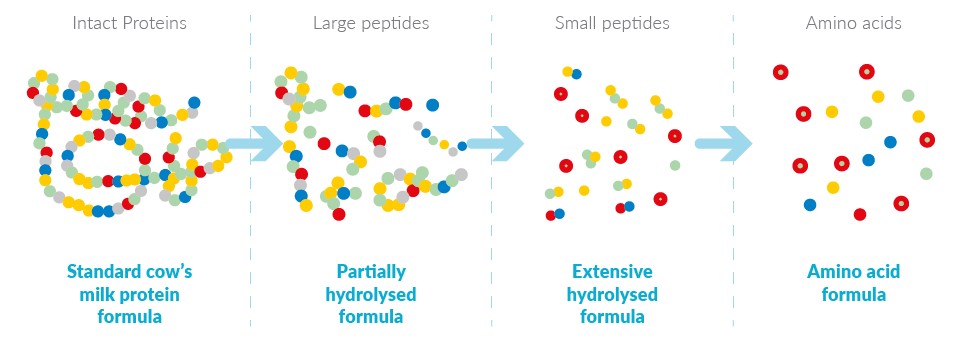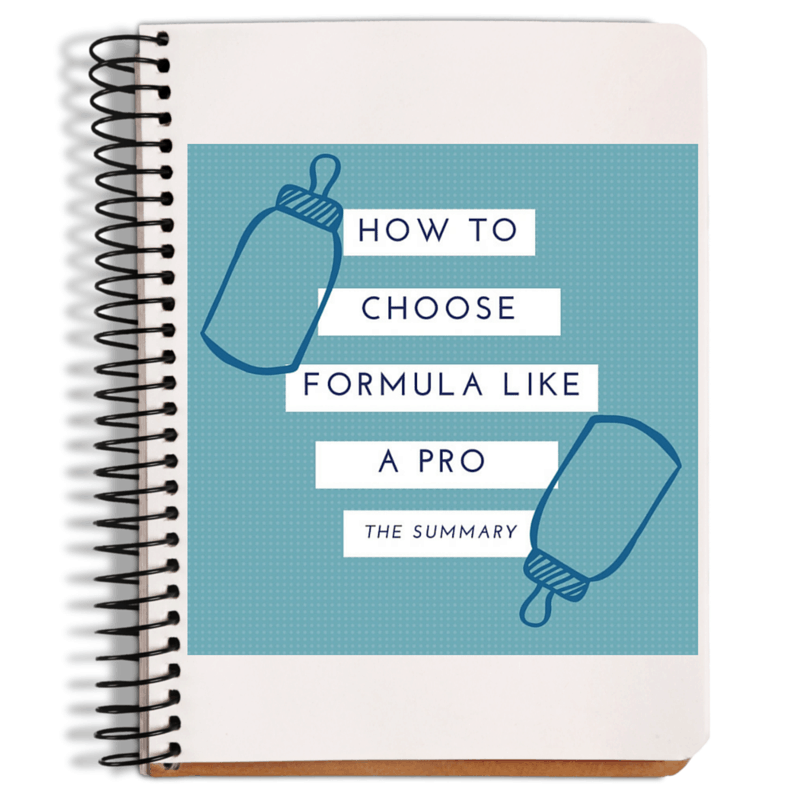How to Choose the Best Baby Formula Series – Baby formula protein type – Hydro-what?
 There is one final topic regarding baby formula protein I have to tell you about. It’s actually a pretty big deal. This is – hydrolysate protein or hydrolyzed protein.
There is one final topic regarding baby formula protein I have to tell you about. It’s actually a pretty big deal. This is – hydrolysate protein or hydrolyzed protein.
Hydrolysis is a process that chops up, or pre-digests, protein so that the protein amino-acid chains are smaller. Proteins that have undergone hydrolysis are referred to as “hydrolyzed” or “hydrolysate protein”.
Healthy infants’ intestines are capable of, and should work to digest protein. However, cow and soy milk proteins are bigger and more allergenic than breast milk proteins. Hydrolyzed proteins are closer to the size of breast milk proteins so they take less work for a baby to digest while still teaching her stomach and intestines how to handle protein.
So – the process of hydrolyzing proteins evens the playing field for formula-fed babies that need a little bit of digestion help. The research on baby formula made with hydrolysate protein is very promising, both for digestive and immune issues. Hydrolyzed proteins may be less allergenic (or immune-response-inducing) for babies who are at risk for food allergies or immune diseases. In fact, there has been good research to show that infants who develop eczema (which is an immune reaction), show improvement when switched to a partially hydrolyzed formula (1).
A very interesting study also found that infants who had a family history of Type 1 diabetes (which is a severe auto-immune condition) were less likely to develop auto–antibodies (translation = signs of early diabetes development) if they were fed hydrolysate protein formula as opposed to standard formula (5).
This is still an active area of research and we don’t fully understand ALL the the interactions that happen between formula proteins and infants’ immune systems. But so far, the research is pretty promising. For all these reasons, I am a big fan of partially hydrolyzed protein for newborns! This is one of the first things I recommend parents of newborns (babies under 3 months) look for on the formula label and talk to their doctor about when they are just starting out.

Proteins in baby formula can be intact (full-size) or either partially or fully hydrolyzed. Most mainstream hydrolyzed baby formulas marketed to healthy infants are only partially-hydrolyzed. I personally think that partial hydrolysis is plenty to provide the health benefits listed above.
Other baby formulas can be extensively hydrolyzed so the proteins are in even smaller chains. These formulas are truly hypoallergenic – meaning the proteins are SO small that they don’t induce any allergic response in most kiddos who have a cow’s milk allergy. These are usually prescribed to infants who are having inexplicable digestion issues or severe allergic reactions. The brands you’ve probably heard of include Nutramigen and Alimentum.
Finally, there are a few baby formulas that only have free amino acids and no actual proteins at all (since proteins are chains of amino acids). Free amino-acid baby formulas are for infants with severe digestive tract issues that are incapable of digesting protein or very severe allergies. Feeding an infant such a formula should be done only under the direction and care of your pediatrician and gastroenterologist.
To know if the proteins in your baby formula are hydrolyzed or not, you have to look in the ingredients list for the words “partially hydrolyzed” before the protein. I’ll repeat my mantra here:
You must read the formula label list of ingredients!
If you just look at the chart that lists grams of protein per serving, you have no idea if that protein is from cow’s milk, soy, has extra whey, or is hydrolyzed. Both cow’s milk and soy based protein can be hydrolyzed but you have to look to find out!
For easy reference , below is a list of all the mainstream name-brand formulas for healthy term infants, and the type of protein they provide.
| Gerber® Good Start | |
|---|---|
| GentlePro | Partially Hydrolyzed 100% Whey protein |
| Gentle (12oz can) | Nonfat cow milk protein plus extra whey protein (70% whey and 30% casein) |
| SoothePro | Partially Hydrolyzed 100% Whey protein |
| Soothe (12oz can) | Nonfat cow milk protein plus extra whey protein (70% whey and 30% casein) |
| Soy | Partially Hydrolyzed Soy protein |
| Enfamil® | |
| Infant | Nonfat cow milk protein plus extra whey protein (60% whey and 40% casein) |
| Gentlease | Partially hydrolyzed – nonfat cow milk plus extra whey protein (60% whey and 40% casein) |
| Reguline | Partially hydrolyzed – nonfat cow milk plus extra whey protein (60% whey and 40% casein) |
| A.R. | Nonfat cow milk (20% whey and 80% casein) |
| Enspire | Nonfat cow milk protein plus extra whey protein (60% whey and 40% casein) |
| ProSobee (Soy based) | Soy Protein Isolate |
| Similac® | |
| Organic | Organic Nonfat cow milk (18% whey and 82% casein) |
| Advance & Pro-Advance | Nonfat cow milk protein plus extra whey protein (48% whey and 52% casein) |
| For Supplementing | Nonfat cow milk protein plus extra whey protein (48% whey and 52% casein) |
| Sensitive & Pro-Sensitive | Nonfat cow milk protein (18% whey and 82% casein) |
| Pure Bliss | Nonfat cow milk protein plus extra whey protein (48% whey and 52% casein) |
| Total Comfort | Partially Hydrolyzed 100% Whey Protein |
| For Spit Up | Cow milk protein isolate (18% whey and 82% casein) |
| Soy Isomil | Soy Protein Isolate |
You probably have one question – If hydrolyzed protein is so much better for little stomachs, why aren’t all formulas made that way?
Answer: I don’t know.
My guess: They are more expensive to make, and not all babies need a smaller protein source.
Before I sign off, I need to address the parent who just read this and is using a formula that has full-size intact proteins. Please don’t panic! If your baby is thriving – then you’ve found the right formula for her!! Literally millions of newborns thrive on intact-protein formulas. This article is to provide you with knowledge about the science and terminology on the label, and written to specifically help parents choose a formula to start with. You are doing a great job!
In the next article, I’ll talk the next major ingredient in baby formula – the carbohydrate.
Take-Home Messages:
Here’s a brief summary of the biggest things to look for:
- Hydrolysis chops up large proteins into smaller, more easily digestible pieces.
- Partially hydrolyzed protein may help treat atopic disease and prevent type 1 diabetes in babies who are at risk for these diseases.
- Look for the words “partially hydrolyzed” before the protein on the list of ingredients!

As the parent of a newborn, I am sure you have lots of spare time to leisurely read through all of my detailed articles. But on the off-chance you don’t have excess leisure time – you can click the button below to get a lovely summary of the take-home points of this flagship article series. I’d love to help!
References:
1.Jin, Y. Y., Cao, R. M., Chen, J., Kaku, Y., Wu, J., Cheng, Y., Shimizu, T., Takase, M., Wu, S. M., and Chen, T. X. (2011) Partially hydrolyzed cow’s milk formula has a therapeutic effect on the infants with mild to moderate atopic dermatitis: a randomized, double-blind study. Pediatr. Allergy Immunol. 22, 688-694.
2. Knip, M., Virtanen, S. M., Seppa, K., Ilonen, J., Savilahti, E., Vaarala, O., Reunanen, A., Teramo, K., Hamalainen, A. M., Paronen, J., Dosch, H. M., Hakulinen, T., and Akerblom, H. K. (2010) Dietary intervention in infancy and later signs of beta-cell autoimmunity. N.Engl J.Med. 363, 1900-1908
2.Alexander, D. D., and Cabana, M. D. (2010) Partially hydrolyzed 100% whey protein infant formula and reduced risk of atopic dermatitis: a meta-analysis. J. Pediatr. Gastroenterol. Nutr. 50, 422-430
3.Greer, F. R., Sicherer, S. H., Burks, A. W., American Academy of Pediatrics Committee on, N., American Academy of Pediatrics Section on, A., and Immunology. (2008) Effects of early nutritional interventions on the development of atopic disease in infants and children: the role of maternal dietary restriction, breastfeeding, timing of introduction of complementary foods, and hydrolyzed formulas. Pediatrics 121, 183-191
4.Martinez, J. A., and Ballew, M. P. (2011) Infant formulas. Pediatr. Rev. 32, 179-189; quiz 189
